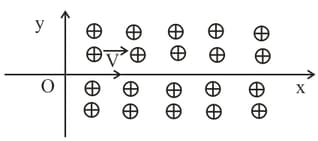A velocity selector is used to select alpha particles of energy . From a beam containing particles of several energies. The electric field strength is . What must be the magnetic field strength in ?
Important Questions on Moving Charges and Magnetism
A velocity selector consists of electric field and magnetic field with . The value required for an electron of energy moving along the positive -axis to pass undeflected is
(Given, mass of electron )
In a region, an electric field and a magnetic field of are applied. A beam of positively charged particles is projected along X-direction. Find the velocity of particles that move undeflected in these crossed fields.
At a place, an electric field and a magnetic field are in the downward direction. There an electron moves in the downward direction. Hence this electron.____________.
(a) a uniform electrostatic field, with initial velocity
(i) parallel to the field,
A proton enters a perpendicular uniform magnetic field B at origin along the positive x-axis with a velocity v as shown in the figure. Then it will follow the following path. [The magnetic field is directed into the paper].

A beam of alpha particles passes undeflected through a velocity selector having electric and magnetic fields of and ,
respectively. The velocity of the beam is :
A particle a mass of carries a charge of . The particle is given an initial horizontal velocity of in the presence of electric field and magnetic field . To keep the particle moving in a horizontal direction, it is necessary that
(i) should be perpendicular, to the direction of velocity and should be along the direction of velocity.
(ii) Both and should be along the direction of velocity.
(iii) Both and are mutually perpendicular and perpendicular to the direction of velocity.
(iv) should be along the direction of velocity and should be perpendicular to the direction of velocity.
Which one of the following pairs of statements is possible?

